Ohio, Ohio, Ohio
Once again, a Presidential election could be decided by the Buckeye State.
Writing about a new poll from a relatively unknown polling firm that shows President Obama with a narrow one percent lead, Nate Silver makes the case that the Buckeye State could end up being the state that decides who will be the next President of the United States:
A one-point lead isn’t much, and Mr. Obama has gotten some better numbers than that in Ohio. So why does this qualify as good news for him? Because this firm has had Republican-leaning results in the other states that it has polled, putting Mr. Romney up by 2 points in Florida, 1 point in Colorado and 17 points in Missouri, making it several points more Republican-leaning than the consensus of surveys in those states. Once the model adjusts for the firm’s”house effect,” it treats Mr. Obama’s nominal 1-point lead as being the equivalent of a 4- or 5-point lead instead. Thus, Mr. Obama’s chances of winning Ohio rose somewhat based on the survey.
The broader point is simply that Ohio is so important to the electoral calculus that it’s good news for a candidate when a polling firm shows him doing relatively well there compared with the other states that it polls. Ohio has a 30 percent chance of being the tipping-point state, meaning that it would cast the decisive votes in the Electoral College. That’s as much as the next two states on the list, Florida and Virginia, combined. It’s also as much as Colorado, Nevada, Iowa, Pennsylvania, New Hampshire, Michigan and North Carolina combined.
All of these states are competitive. But really, they exist along a continuum of electoral power rather than falling into binary categories of “important” and “unimportant.” Ohio is at the extreme end of that continuum.
The reason our tipping-point calculus rates Ohio so highly is because it would usually suffice to provide Mr. Obama with a winning map, even if he lost many of those other states. If you give Ohio to Mr. Obama, plus all the states where the forecast model now estimates that he has at least 75 percent chance of winning, he’s up to 265 electoral votes. That means he could win any one of Colorado, Virginia, Iowa, Wisconsin, Florida or North Carolina to put him over the top.
Mr. Romney is fortunate in this sense to have put Wisconsin squarely into play with his selection of Paul D. Ryan as his running mate; it gives him a few more ways to win without Ohio, although it would still be a daunting task.
This wouldn’t be the first time that Ohio decided a Presidential Election, of course. Indeed, the state ended up being so close that John Kerry waited until the morning after Election Day to concede the state, and the race, to President Bush. In the end, Bush had won the state by a deceptively slim 118,776 votes, a .67% margin of victory. (Interestingly, that year the state with the closest margin of victory was Wisconsin, where Kerry won by a slim .37% of the vote, perhaps an indication that Wisconsin has been a close state for longer than many current observers had realized) Moreover, no Republican has ever won a Presidential election without also winning Ohio (Democrats have won the White House several times without Ohio, most recently.) So, it wouldn’t be at all surprising for America to be up until the wee hours of the morning of November 7th looking to the Buckeye State to decide the face of the nation. Indeed, given the current political atmosphere, I wouldn’t at all be surprised to see the state become 2012’s version of Florida if the result ends up being close enough, with calls for recounts and possibly even lawsuits once again putting the denoumont of the Presidential Election in doubt just as it was in 2000.
Currently, the state seems to be as close as it possibly can be. In addition to the poll noted above, a new poll from the Columbus Dispatch this week has the race tied at 45-45, while one from the University of Cincinnati has Obama up three but within the margin of error. The anomalous poll seems to be the CBS/NYT/Quinnipiac poll which showed Obama up six in the state. Presently, the RealClearPolitics Average, which doesn’t currently include the new poll, has Obama with a +1.4 advantage, but the trend seems to show Romney catching up to the President:
Silver’s model, meanwhile, gives the President a 60.8% chance of winning the state:
With numbers like this, the Buckeye State is sure to be a battleground for the next ten weeks and, just as in 2004, we’re likely to see the fate of the election come down to this one state.
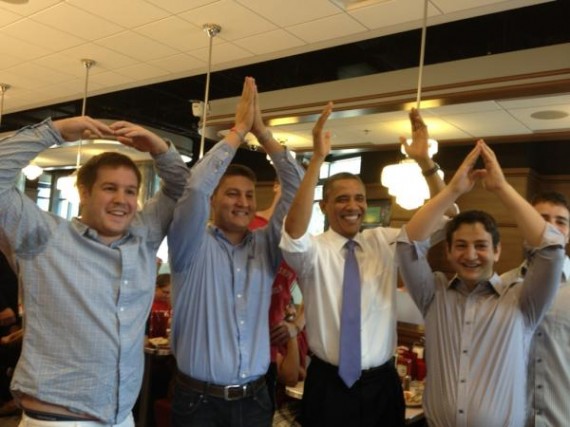
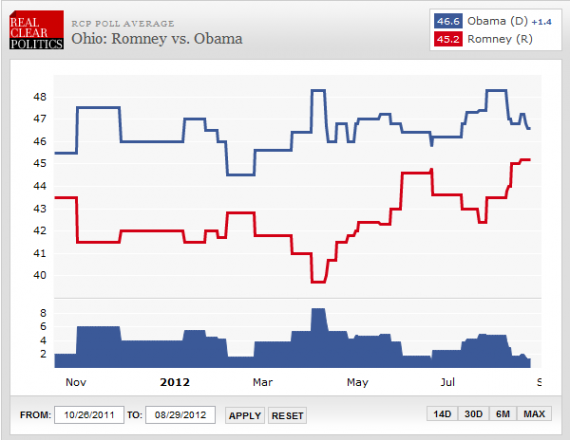
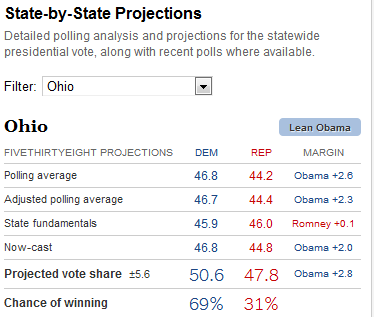

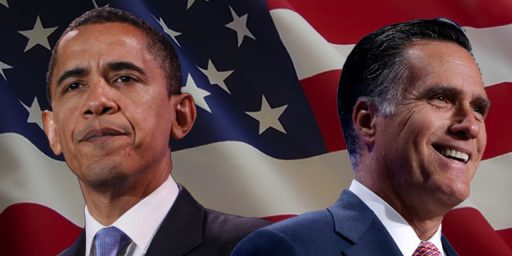
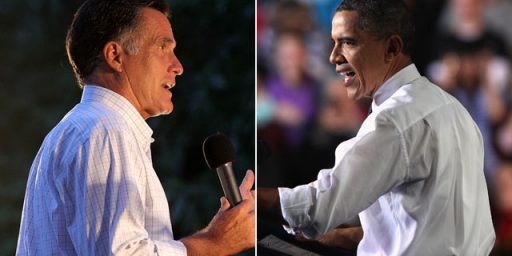

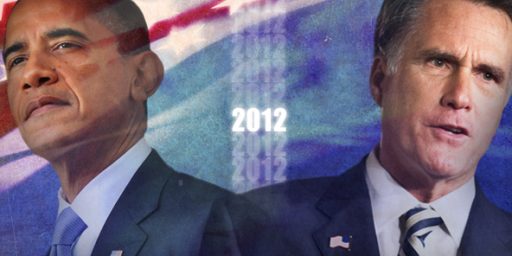
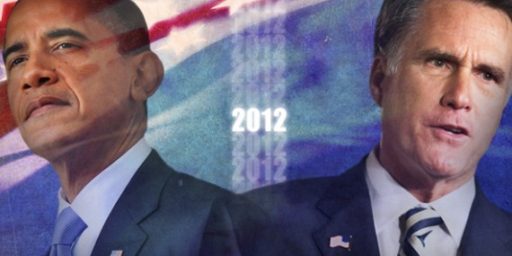
Romney effectively can’t win without Ohio. He’ll also need Florida, Virginia, and North Carolina but I can’t imagine a scenario where he wins Ohio but fails to carry any of those states.
I can’t believe the election is in just ten weeks.
I can’t believe we’ve still got ten more weeks until the election.
@Doug Mataconis:
The image says 69%.
But then I’m not sure if Silver is factoring in Republicans doing everything they can to make it harder to vote for certain groups, so 60.8% may be more accurate…
All the more reason why Portman should have trumped Ryan, but that’s water under the bridge.
Ohio will be a tough nut for Obama to crack, but ironically enough the positive response by the local economy to Kasich’s and the GOP state legislature’s recent legislative policies will help him out. Of course Cuyahoga County on Election Day despite presumed countermeasures likely will resemble Chicago ’60. Bring out ‘yer dead….
@James Joyner:
Having lived most of my life in Ohio and now living in Florida I can see Obama winning FL and losing OH. Ryan did himself no favors with last nights speech in either state given the media pushback on the dishonesty. I think Obama has to be the favorite to win both, Medicare (once facts are out) dooms Romney in FL, a combination of improving economy, toxic GOP brand, unions,and saving auto industry (once Romney dishonesty is fleshed out) dooms Mitt.
Also the McCain WAR!! speech last night was not helpful to Romeny. Most under reported aspect of the evening.
So for, the lasting impression I’ve taken from this convention is that Chris Christie would have been a far more capable and viable candidate than Gingrich, Santorum, Perry, West, Pawlenty, and Bachmann combined.
Would anyone care to provide some proof that Kasich and the GOP legislature are the reasons that Ohio’s economy is doing better than the country’s as a whole? I’m sure that GM’s resurgence has nothing to do with it, right? And with the reference to 1960, it’s nice to know that Tsar Nicholas practices the same chicanery that Paul Ryan does…
A fact that I haven’t seen mentioned anywhere: OH has the best (recent) record of picking POTUS winners. The last time they didn’t pick the winner was 1960. Second best record: Nevada. Since 1956, they’ve been wrong only once (1976).
So the last time someone became president without winning OH was 1960. And no R has ever become president without winning OH.
“Writing about a new poll from a relatively unknown polling firm that shows President Obama with a narrow one percent lead, Nate Silver makes the case that the Buckeye State could end up being the state that decides who will be the next President of the United States:”
I would trust Nate Silver as far as I can throw him. He works for the NY “Pravda” Times, so his livelihood depends on pushing the Lib agenda – even if it means slightly jiggering his models and stats to push his employer’s agenda. I trust him about as much as I trust all those NY Times/CBS/Time/CNN/etc polls that have Obama sweeping all the battlegrounds with margins in the 6 – 8% range by oversampling and juicing turnout models for Dems by margins of 10% +/- over Repubs.
Quite frankly, what’s most ominous for the President is all these Swing State polls that have him at 43% – 45%. No way he wins if he can’t get above the mid 40s, as the late breakers will almost surely break for the new kids on the block versus the guy that has been there the past 4 years. In other words, if they aren’t with Obama now, I doubt he’s going to get them later.
” I trust him about as much as I trust all those NY Times/CBS/Time/CNN/etc polls that have Obama sweeping all the battlegrounds with margins in the 6 – 8% range by oversampling and juicing turnout models for Dems by margins of 10% +/- over Repubs.”
Exactly what advantage do you suppose this provides for Obama? The most likely result of over-reporting Obama’s chances of winning seems to be depressed Democratic turnout.
You’ll have to forgive Smooth Jazz…he and logic aren’t very well acquainted with each other…
@Smooth Jazz:
So, in other words you base your preference for information not on whether it is accurate or not, but on where it is published?
I suggest that if you look at Silver’s work you will find a) he does a pretty meticulous job at analysis, b) it is well founded in empirics, and c) he has a rather impressive track record prediction-wise.